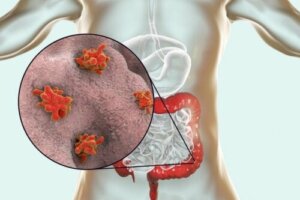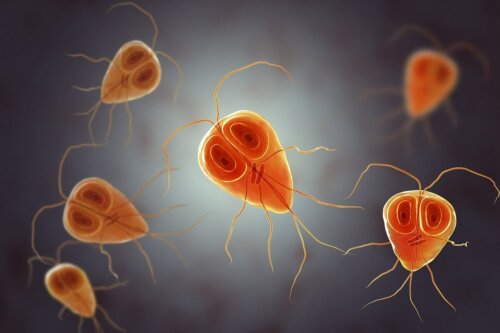Diseases Caused by Protozoa


Written and verified by the biologist Samuel Antonio Sánchez Amador
Symptoms such as fever, malaise, severe skin rashes, and even tachycardia are signs of diseases caused by protozoa. Above all, there are two ways protozoan pathologies occur. For one, by consuming contaminated water. Secondly, by getting bitten by an invertebrate that has these microorganisms in its body.
Various scientific studies have talked about these zoonotic-type diseases. Do you know what a protozoan is? Do you know the most typical diseases that these living beings cause? Understanding the epidemiological dynamics of pathogens is essential in order to learn how to avoid them. Keep reading this article to learn more!
What are protozoa?
Protozoa are heterotrophic microorganisms, which means they feed on organic matter. They live in humid environments; either in completely aquatic environments or in superficial films of water on land.
According to sources such as Clinical Microbiology Reviews, the protozoa kingdom is made up of 18 different phyla that comprise around 30,000 species. The most widely used classification divides these characteristic microorganisms into four groups.
- Rhizopods
- Ciliates
- Flagellated
- Sporozoans
Their size varies from 10 to 50 micrometers. Additionally, they move through liquids by using appendages called flagella. Studies say that many species are free-living, while others have specialized in parasitizing humans and other vertebrates (wild or of agricultural interest).
Diseases caused by protozoa
Due to the nature of the causative pathogens, protozoan diseases are more of a problem in low-income countries. These can occur in all types of population groups regardless of sex or age. However, they’re definitely more prevalent in young children.
For example, a study conducted in a region of Circassia found that out of 79 children sampled, up to 22% had the protozoan parasite Giardia lamblia in their gastrointestinal tract. This value is quite high when you take into account the research sample size.
Other statistical samples further support the vulnerability of infants to these gastrointestinal protozoa. For example, in a study carried out in Valdivia (Chile), the researchers were able to observe that, out of 219 infant stool samples, 34% of them contained the pathogen Entamoeba coli.
This high prevalence of pathogenic protozoa has everything to do with the lack of sanitation and fecal contamination of water for public consumption. Let’s see a list of the most common diseases caused by protozoa.

Toxoplasmosis
The species Toxoplasma gondii, an obligate intracellular parasite, is the cause of this disease. This protozoan can be asymptomatic in a human being, however, the problem arises when it’s transmitted to the fetus of a pregnant woman.
In many cases, the fetus can die from the infection, but in healthy people, the probability of not showing symptoms is 80%.
According to the Global Water Pathogen Project (GWPP), in South America, most infections occur from contaminated water. On the other hand, in high-income countries, the most common method of contagion is through contact with felines not treated by veterinarians.
Giardiasis
This is a diarrheal disease caused by the previously mentioned protozoan, Giardia lamblia. It lives in the small intestine of the infected person and is transmitted through the feces of a sick animal or human being.
Moreover, it’s a cosmopolitan parasite (it occurs in all regions of the world). Additionally, it’s important to note that it especially affects children, who can suffer severe malnutrition if they don’t get treatment. Giardiasis has symptoms such as abdominal pain, bloating, and profuse diarrhea.
Read also: The symptoms and treatment of giardiasis
Trypanosomiasis
African human trypanosomiasis or “sleeping sickness” is a pathology caused by the Trypanosoma protozoa. According to the World Health Organization (WHO), its fatality rate is near 100% in untreated patients.
The infection is caused by the bite of a tsetse fly that contains the pathogen. Its symptoms include skin ulcers in the first instance, followed by fevers, headaches, anemia, weakness of the circulatory system, and weight loss.
Malaria
Malaria is a pathology caused by the protozoan parasite of the Plasmodium genus. Many NGOs pay particular attention to this pathogen, as, in West Africa, experts estimate that more than 2 million people die each year from this disease, of which 75% are children.
The main transmitting vectors of this parasite are mosquitoes of the Anopheles genus. These harbor the protozoan in their body and pass it into the human bloodstream with the bite. Symptoms vary widely, from fevers and chills to nausea, vomiting, and coughing up blood.

Other protozoan pathologies
- Leishmaniasis: caused by protozoa of the Leishmania genus. Its symptoms range from skin rashes to fatal forms that cause inflammation of the liver and spleen.
- Trichomoniasis: this is a sexually transmitted disease caused by the Trichomonas vaginalis species. While some people are asymptomatic when infected, others tend to experience mucous secretions in their intimate parts and intense itching.
- Balantidiasis: caused by the Balantidium coli parasite. It reaches humans through contaminated water and food, and symptoms usually include mild diarrhea and abdominal pain.
Read also: The main pathogens during summer
What you should remember about diseases caused by protozoa
Protozoa are microorganisms that occur in a general way in all environments. Nonetheless, they’re especially prevalent in warm places with little sanitary control, usually low-income areas.
Furthermore, many of the aforementioned pathologies occur in tropical or very hot countries since invertebrates, such as mosquitoes and flies, are the main transmission vectors.
Although there are specific medications for each of the pathologies we mentioned, good prevention is always key. For this, not consuming non-potable water or food without sanitary control is essential.
All cited sources were thoroughly reviewed by our team to ensure their quality, reliability, currency, and validity. The bibliography of this article was considered reliable and of academic or scientific accuracy.
- Protozoo, wikipedia. Recogido a 28 de junio en https://es.wikipedia.org/wiki/Protozoo
- González, A. F., Cuartero, I. G., Díez, A. G., & Fernández, P. F. (2014). Infecciones por protozoos hemoflagelados: leishmaniasis, enfermedad de Chagas y tripanosomiasis africana. Medicine-Programa de Formación Médica Continuada Acreditado, 11(54), 3194-3207.
- Cavalier-Smith, T. (1993). Kingdom protozoa and its 18 phyla. Microbiology and Molecular Biology Reviews, 57(4), 953-994.
- Alvarez, A. R. (2017). Los protozoos: características generales y su rol como agentes patógenos. Ciencia Veterinaria, 8(1), 62-71.
- Arias, J. A., Guzmán, G. E., Lora-Suárez, F. M., Torres, E., & Gómez, J. E. (2010). Prevalencia de protozoos intestinales en 79 niños de 2 a 5 años de edad de un hogar infantil estatal en Circasia, Quindío. Infectio, 14(1), 31-38.
- Arias, J. A., Guzmán, G. E., Lora-Suárez, F. M., Torres, E., & Gómez, J. E. (2010). Prevalencia de protozoos intestinales en 79 niños de 2 a 5 años de edad de un hogar infantil estatal en Circasia, Quindío. Infectio, 14(1), 31-38.
- Navarrete, N., & Torres, P. (1994). Prevalencia de infección por protozoos y helmintos intestinales en escolares de un sector costero de la provincia de Valdivia, Chile. Bol. chil. parasitol, 49(3/4), 79-80.
- Global Water Pathogen Project. Toxoplasma gondii. Recogido a 28 de junio en http://www.waterpathogens.org/node/158
- Ejecutivo, C. (2004). Control de la tripanosomiasis africana humana: informe de la Secretaría (No. EB113/5). Organización Mundial de la Salud.
- Breman, J. G. (2001). The ears of the hippopotamus: manifestations, determinants, and estimates of the malaria burden. The American journal of tropical medicine and hygiene, 64(1_suppl), 1-11.
This text is provided for informational purposes only and does not replace consultation with a professional. If in doubt, consult your specialist.








